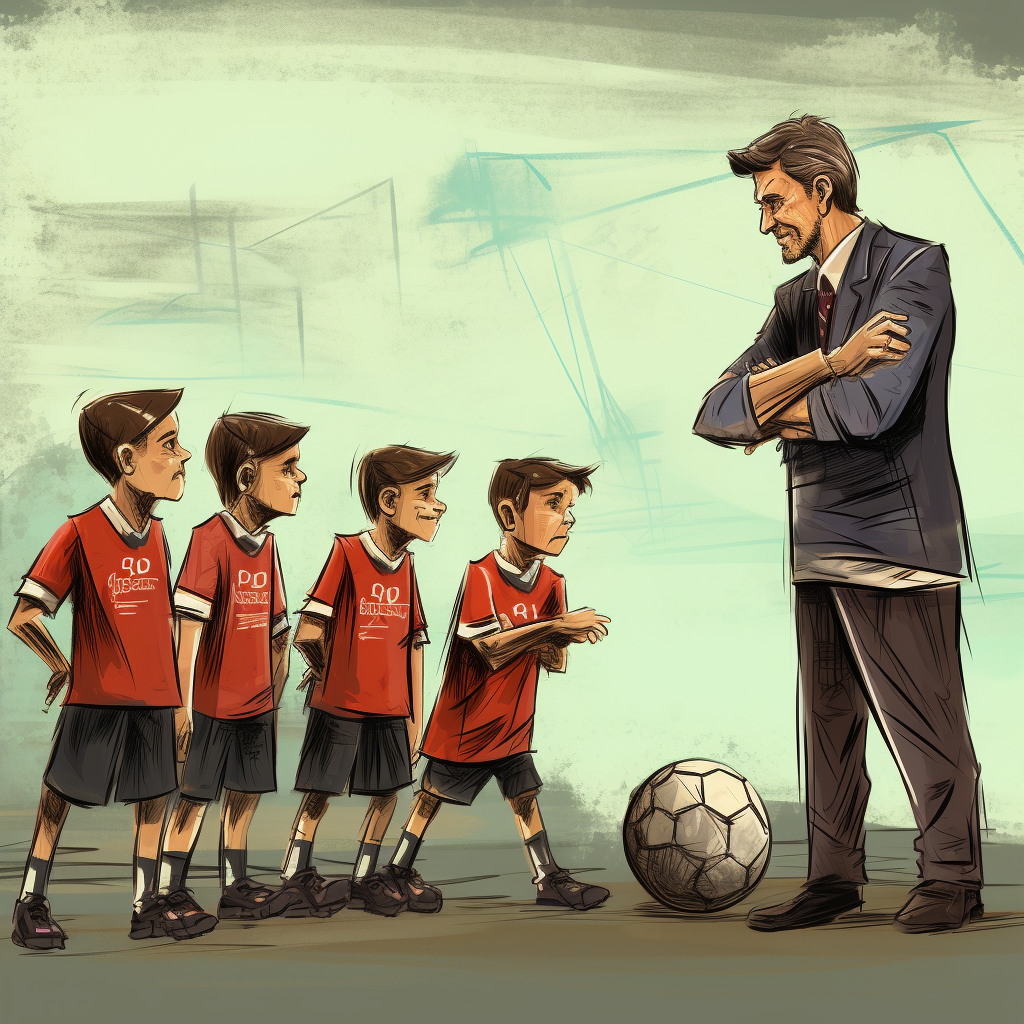Effective Communication Between Soccer Coaches, Parents, and Young Players
Effective communication between coaches, parents, and young players is crucial in the development of a healthy and successful soccer environment.
Establishing clear lines of communication can help create a positive atmosphere, where all parties are well-informed and working towards the same goals.
Communication plays a vital role in managing expectations, addressing concerns, and fostering collaboration between all parties involved.
Understanding the unique dynamics of coach-parent-player relationships is essential in order to develop effective communication strategies.
Each party brings different perspectives, expectations, and responsibilities to the table.
Recognizing these differences, as well as the importance of open and honest dialogue, can help establish a respectful and trusting atmosphere where everyone can thrive.
Incorporating specific communication techniques, such as active listening and empathy, can aid in the resolution of conflicts and ensure that everyone feels heard and understood.
Taking the time to ensure clear communication channels can ultimately lead to a more enjoyable and rewarding experience for all involved in the world of youth sports.
Key Takeaways
Effective communication helps create a positive and collaborative soccer environment
Understanding different perspectives is crucial in establishing respectful and trusting relationships
Utilizing specific communication techniques can help resolve conflicts and ensure a positive sports experience for all parties involved.
Importance of Effective Communication
Building Trust
Effective communication plays a crucial role in building trust between coaches, parents, and young players. Coaches and parents should:
Be open and honest: Share information, goals, and expectations with each other.
Listen actively: Give full attention to each other and acknowledge their concerns.
Show empathy: Understand the feelings and emotions of the young players.
Establishing trust encourages a positive environment where players feel comfortable and confident in sharing their thoughts and emotions.
Ensuring Safety
Clear and concise communication is vital for ensuring the safety of young players. To promote safety, coaches and parents can:
Set clear guidelines: Establish rules and regulations for players to follow during practice and games.
Inform about potential hazards: Communicate about potential risks and best practices to avoid injuries.
Handle emergencies: Create a plan for handling emergencies and make sure everyone is familiar with their roles.
By emphasizing safety, coaches and parents create an environment where young athletes can focus on their development without fearing any harm.
Enhancing Performance
Effective communication also plays a significant role in improving the overall performance of young athletes. To enhance performance, all parties should:
Emphasize on constructive feedback: Coaches should provide clear and concise feedback to help players identify areas for improvement. Parents can support the process by reinforcing the coach’s messages.
Recognize achievements: Celebrating the athlete’s accomplishments, both big and small, boosts their self-esteem and motivates them for future challenges.
Adapt communication style: It’s essential to tailor communication style based on individual needs, as different players respond to different approaches.
In summary, effective communication between coaches, parents, and young players is imperative for building trust, ensuring safety, and enhancing performance.
Using various strategies and adjusting communication styles, all parties can work together toward achieving their collective goals and ensuring the success of each athlete.
Understanding the Audience
Age-Appropriate Communication
When communicating with young players, it is essential to use age-appropriate language and to adjust the complexity of the message accordingly. For example:
Younger children (4-7 years): Use simple and clear language, focus on basic concepts like fair play and teamwork.
Older children (8-12 years): Introduce more complex concepts such as strategy and position-specific techniques.
Teenagers (13-18 years): Discuss advanced strategies, personal goals, and adapting to changing circumstances on the field.
Cultural Considerations
Additionally, it is crucial to be mindful of any cultural sensitivities when communicating with players and their parents. This may include:
Language barriers: Consider providing translations when necessary, or seek help from interpreters or bilingual team members.
Cultural norms: Understand that individuals may have different expectations around communication styles, respect, and authority.
Religious practices: Be aware of any religious practices that might impact the player’s ability to participate fully in team activities, and try to accommodate these when possible.
Individual Personalities
Finally, recognizing the personalities of players and their parents is essential when attempting to effectively engage with them. Some points to consider:
Introverts: Allow time for individual reflection and encourage quieter players to share their thoughts in smaller groups or one-on-one settings.
Extroverts: Appreciate their energy and enthusiasm but try to guide their focus on the team’s overall goals and strategies.
Performance-anxious individuals: Offer reassurance and constructive feedback, and try to create training environments that focus on individual progress rather than constant comparison with others.

Communication Techniques
Effective communication between coaches, parents, and young players is crucial for success in any sports environment. In this section, we will explore three key communication techniques: Active Listening, Clear Messaging, and Feedback and Critique.
Active Listening
Active listening is the foundation of effective communication.
This involves coaches paying full attention to what players are saying, showing genuine interest, and providing them with space to express their thoughts and concerns.
By actively listening, coaches build trust and encourage open dialogue, allowing them to better understand individual needs and tailor their approach accordingly.
To practice active listening, coaches can:
Maintain eye contact with the speaker to show engagement.
Paraphrase or summarize what the speaker said to ensure understanding.
Ask open-ended questions for clarification or to show interest.
Clear Messaging
Clear messaging is vital for minimizing misunderstandings and ensuring that players receive the necessary information. Coaches should:
Be concise: Keep the message brief, using plain language to avoid confusion2.
Stay organized: Present information in a logical order, making it easier for players to follow.
Use appropriate tone and body language: Both verbal and non-verbal cues impact the message. Coaches should remain calm and maintain a neutral tone.
It’s also important for coaches to finish conversations with a check for understanding3. This can be done by asking players to summarize their takeaways from the conversation and clarifying any misunderstandings.
Feedback and Critique
Providing constructive feedback and critique is essential for player growth and development. Coaches should:
Be specific and objective: Point out the exact actions or behaviors that need improvement4.
Focus on the process, not just the outcome: Emphasize the learning process, helping players develop good habits and decision-making skills.
Encourage self-reflection: Ask players to evaluate their own performance and identify areas for improvement.
A strategy for delivering feedback is the sandwich approach:
Start with a positive observation or compliment.
Address the area needing improvement.
End with another positive observation or encouragement.
By employing these communication techniques, coaches, parents, and players can establish strong relationships, leading to a successful and enjoyable sports experience.
Communicating Through Conflict
Conflict Resolution
Active listening plays a crucial role in effective communication strategies and can help alleviate conflicts. Encourage the speaker by:
Asking questions
Showing interest
Validating their perspective
Restating main points through paraphrasing
It’s important to keep in mind that showing interest in the speaker does not necessarily mean agreeing with their point of view.
Setting Boundaries
To promote a healthy environment between coaches, parents and young players, it is essential to establish clear and mutually agreed-upon boundaries. Consider the following aspects:
Roles and responsibilities: Define the roles of coaches, parents, and athletes in the sports environment.
Communication guidelines: Set acceptable methods and frequency of communication for all parties.
Behavioral expectations: Establish codes of conduct for practices, competitions, and off-the-field interactions.
By effectively managing relationships, coaches can encourage parents to be more involved and supportive in the young athlete’s development.
Managing Expectations
Inadequate communication and mistrust between parents and coaches can result in a lack of shared goals, possibly affecting the athlete’s development.
To manage expectations, encourage open dialogues where coaches, parents, and athletes can:
Discuss individual and team goals
Share perspectives on the athlete’s progress
Address any concerns or misconceptions
Through transparency and ongoing communication, coaches and parents can build trust, allowing them to work toward a common goal of nurturing the athlete’s development and success in sports.
Role of Technology
Digital Communication Tools
In recent years, technology has played a significant role in enhancing communication between coaches, parents, and young players.
A variety of digital communication tools are available to facilitate interaction and collaboration.
For instance, team management apps like TeamSnap and Band enable coaches to share schedules, send notifications, and track player progress.
These platforms also allow parents to stay updated on their child’s performance and communicate with the coaching staff.
Online video conferencing tools like Zoom and Google Meet can be utilized for virtual team meetings, training sessions, and parent-coach conferences. This allows for increased flexibility, as participants can engage from the comfort of their homes.
Email: A reliable channel for sharing important updates, announcements, and documents.
Text messaging: Allows for quick, real-time communication between coaches, parents, and players.
Dedicated apps: Apps designed specifically for sports management and communication.
Social Media Policies
To ensure effective communication, it is crucial to establish clear social media policies for coaches, parents, and young players.
These policies should outline the appropriate use of social media platforms (e.g., Facebook, Twitter, Instagram), define acceptable conduct, and specify any online activities that are off-limits. Establishing ground rules for social media interactions can help:
Prevent misunderstandings or misinterpretations of online communications.
Protect the image and reputation of the team and its members.
Promote a positive, safe, and supportive online environment.
Coaches should communicate these policies at the beginning of the season and emphasize their importance throughout the year.
Privacy Concerns
With the widespread use of technology in sports, privacy concerns have emerged as a crucial consideration.
Coaches, parents, and athletes should be aware of the potential risks associated with sharing personal information online. To address these challenges:
Limit the amount of personal information shared on public platforms (e.g., be cautious when posting full names, addresses, or phone numbers).
Use private or closed team communication channels whenever possible.
Regularly review and adjust privacy settings on social media platforms.
By being proactive about privacy and implementing appropriate security measures, coaches and parents can help ensure the safety and wellbeing of young athletes in today’s digitally connected world.
Communication Planning
Pre-Season Meetings
Pre-season meetings are an essential component of setting the foundation for effective communication between coaches, parents, and young players.
During these meetings, the coach should share their plan with parents, players, and other coaches, addressing guidelines, expectations, and answering any questions from the audience.
It is recommended that meetings not exceed one hour and fifteen minutes in length to maintain productivity and prevent losing the focus of attendees.
Agenda Items to Cover:
Coaching philosophy and goals for the season
Team rules and expectations
Practice and game schedules
Parent involvement and volunteering opportunities
Communication channels (email, text messages, social media, etc.)
Regular Updates
Providing regular updates helps maintain a consistent line of communication throughout the season.
The coach can utilize various methods such as email, group chats, or team websites to keep everyone informed. Important information to share includes:
Team updates: Player progress, game results, and any changes in team dynamics.
Schedule reminders: Upcoming games, practices, and other team events.
Resource distribution: Sharing relevant articles, videos, or external resources to help players and parents better understand the sport and its techniques.
It is critical that the coach remains approachable and encourages open communication from players and parents, fostering trust and collaboration ^[2]^.
Crisis Communication
Crisis situations, such as injuries, conflicts between players, or sensitive issues, require coaches to have a structured communication plan in place to navigate these challenges effectively. Key elements to consider when managing crisis communication include:
Empathy: Demonstrate understanding and caring towards affected individuals and families.
Timeliness: Addressing the situation promptly, without rushing to conclusions.
Transparency: Updating relevant parties with accurate information while respecting privacy.
Consistency: Ensuring the tone and message shared with all stakeholders remain constant and in line with the overall plan.
In conclusion, effective communication between coaches, parents, and young players involves pre-season planning, regular updates, and crisis management.
By implementing these strategies, coaches can cultivate a positive environment, promote trust, and ultimately help the team succeed.
Legal and Ethical Considerations
Abuse Prevention
It is crucial for coaches, parents, and young athletes to create a safe and positive environment. This includes preventing sexual, physical, and emotional abuse in sports. A few measures can be taken to create a supportive atmosphere:
Establishing clear boundaries between coaches, parents, and athletes to ensure a professional and appropriate relationship.
Developing a robust reporting system for any concerns or allegations of abuse, allowing athletes and parents to feel confident in coming forward.
Providing regular trainings and education on abuse prevention and detection for coaches, parents, and athletes alike.
Confidentiality Issues
One important aspect of communication between coaches, parents, and players is the protection of personal information. This can involve medical records, personal issues outside of sports, or any sensitive details related to an individual’s performance.
The following steps can help in maintaining confidentiality:
Ensuring that any information shared between parties is relevant and necessary for the athlete’s development and well-being.
Storing personal information securely and limiting access to authorized individuals only.
Seeking consent from athletes and parents before disclosing any sensitive information to others outside of the communication triad (coach-athlete-parent).
Mandatory Reporting
As part of their duties, coaches and parents are often obligated to report instances of abuse, neglect, or danger that may impact the safety of young athletes.
This legal requirement, known as mandatory reporting, implies that in certain situations, coaches and parents must prioritize the interests of the athletes over other considerations.
Some guidelines on mandatory reporting include:
Familiarizing oneself with local legislations and reporting policies.
Informing athletes and parents about these laws and policies, and discussing them openly.
Taking immediate and appropriate action in case of suspicion or disclosure of abuse, neglect, or danger concerning an athlete.
By addressing these legal and ethical considerations, coaches, parents, and athletes can foster an environment where effective communication thrives, and the well-being of young athletes is prioritized.
Training for Effective Communication
Coaching Education
An important aspect of effective communication in youth sports is ensuring that coaches are well-trained in communication techniques.
This can be achieved through regular workshops or courses covering various communication principles, strategies, and tools.
Topics in coaching education may include active listening, providing constructive feedback, understanding body language, and adjusting communication styles to meet individual player needs.
Active listening techniques:
Maintaining eye contact
Paraphrasing or summarizing what was said
Asking open-ended questions
Providing verbal and non-verbal acknowledgment
Parent Workshops
As the parents play a significant role in young athletes’ development, it is essential to involve them in the communication process.
Hosting parent workshops can help build a positive coach-parent relationship by educating parents on expectations, team policies, and communication strategies they can utilize to effectively support their children.
Topics for parent workshops may include understanding their child’s mental and emotional needs, the importance of sportsmanship, and establishing open communication channels with coaches and players.
Topics for parent workshops:
Mental and emotional needs of young athletes
Sportsmanship and fair play
Open communication channels with coaches and players
Player Leadership Development
Developing leadership skills in young athletes is crucial to creating an environment conducive to effective communication.
Player leadership development programs may focus on teaching players how to express their thoughts clearly, listen and respond effectively, and how to lead by example.
These activities should be integrated into regular training sessions and may even give players opportunities to apply their skills in game situations.
Leadership development activities:
Role-playing exercises for effective communication under pressure
Group discussions on team dynamics and problem-solving
Peer-to-peer feedback sessions for constructive criticism
By focusing on coaching education, parent workshops, and player leadership development, youth sports organizations can create a positive and supportive environment for effective communication between all parties involved.
Examples of Good Practices
Successful Case Studies
One example, mentioned by Michigan State University, focuses on parents who emphasize the process of improvement, buy-in to the coach’s philosophy, react positively to their child regardless of the outcome, and act as a positive role model for their child in terms of attitude and effort.
Another case study from Soccer Parenting describes a situation where a coach effectively communicates with a young goalkeeper, providing sound and helpful advice on improving the psychological aspects of her game.
Testimonials
Parents and coaches alike have observed the benefits of effective communication and collaboration. Some of the key testimonials include:
Coaches acknowledging that meaningful engagement with parents helps build trust and mutual understanding.
Parents feeling valued and involved when they collaborate with coaches in supporting their child’s development.
Young athletes expressing a boost in confidence and motivation when they see their parents and coaches working together as a team.
Review and Adaptation
The process of review and adaptation is crucial in ensuring that good practices are maintained and improved upon. Some methods to review and adapt include:
Regular meetings between parents and coaches to discuss progress and any concerns.
Using tools like iSport360 to help track performance and set goals for young athletes.
Encouraging open feedback and communication between all parties.
Providing resources to parents, such as articles, books, or online resources, so they can better understand the physical and emotional needs of their young athlete.
Emphasizing good practices like the ones in these examples can help all parties work together effectively to support the development and success of young athletes.
Evaluation and Feedback
Surveys and Questionnaires
One effective method to evaluate communication between coaches, parents, and young players is through the use of surveys and questionnaires.
These tools can help gather feedback about the overall experience of each party throughout the season.
For example, a coach might distribute a survey for parents to assess the clarity and frequency of communication, while players might complete a questionnaire about their understanding of the coach’s instructions.
Continuous Improvement
The main goal of evaluation and feedback is to enable continuous improvement in coaching strategies, parent engagement, and player development.
Analyzing the feedback received from the surveys and questionnaires can help coaches identify areas that require improvement, while also highlighting successful communication methods.
By addressing these areas, coaches can ensure that they are fostering an environment that promotes growth and learning for all parties involved.
Identify areas that need improvement
Implement changes based on feedback
Evaluate the effectiveness of the changes made
Recognition of Excellence
Feedback collected should not only focus on areas that need improvement but also on recognizing excellence within the team, both from the coach as well as the players and parents.
Celebrating achievements, hard work, and dedication can further strengthen the relationships between all parties and motivate them to continue contributing to the team’s success.
To incorporate recognition of excellence, consider:
Organizing an end-of-season awards ceremony
Announcing individual and team accomplishments during team meetings
Sending personalized messages or letters to players and parents to express appreciation for their efforts
By implementing these practices, coaches can encourage a positive and collaborative environment that facilitates effective communication with parents and young players throughout the season.
Frequently Asked Questions
How can coaches effectively share their coaching philosophy with parents and staff?
Coaches should organize a pre-season meeting with parents and staff to introduce their coaching philosophy. They should be clear and concise about their coaching style, expectations, and goals for the team. Encourage open dialogue for any questions or concerns the parents or staff may have. Maintaining open and regular communication will help build a strong relationship between everyone involved.
What strategies can coaches use to ensure clear communication with young players?
To ensure that young players understand the coach’s message, use simple language, and avoid jargon. Summarize key points and ask players for their takeaways from the conversation to check their understanding. Additionally, coaches can follow up on important discussions with an email, copying the player’s parent for clarity and reinforcement.
What are the key components of successfully interacting with parents in youth sports?
The key components of successful interactions with parents include setting boundaries, being approachable, and actively listening. Coaches should clearly communicate the expectations for parental behavior during practices, matches, and team events. They should also be open to hearing parents’ concerns and addressing them promptly and professionally.
How should a coach approach a conversation with a parent who wants to discuss their child’s performance?
When discussing a child’s performance, coaches should remain professional and empathetic. They can start by understanding the parent’s perspective and communicate their intentions in the best interest of the child. During the conversation, coaches should highlight the player’s strengths while also discussing areas for improvement in a constructive manner.
What do coaches expect from parents regarding communication and involvement?
Coaches expect parents to support the team positively, respect their coaching decisions, and not interfere with coaching during games. Parents should maintain open communication with coaches, address concerns promptly, and actively engage in their child’s development. Coaches also value parental assistance in organizing team events and maintaining a supportive environment.
What are the four essential skill sets for interscholastic teachers/coaches in communicating effectively?
The four essential skill sets for interscholastic teachers/coaches in effective communication include active listening, verbal communication, non-verbal communication, and providing feedback. Coaches should be able to listen to concerns, articulate their thoughts clearly, convey messages through body language, and give constructive feedback to players and parents.













Leave a Reply